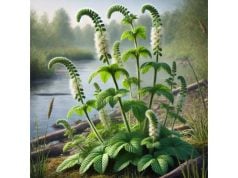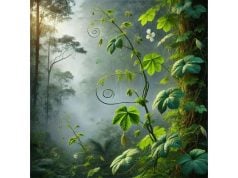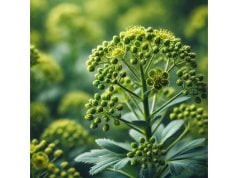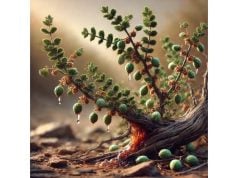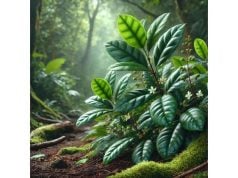
Green Alder (Alnus viridis), also called mountain alder or slide alder, is a versatile shrub or small tree renowned for stabilizing steep slopes and enriching soil quality. From a medicinal standpoint, it has been traditionally valued for its anti-inflammatory and diuretic attributes. Herbal practitioners have used various parts of the plant—especially the bark and leaves—to create teas, poultices, and washes aimed at soothing skin irritations and aiding minor wound care. Additionally, some Native American groups incorporated Green Alder in treatment strategies for fevers and discomfort. In this extensive guide, we will uncover its botanical features, delve into its phytochemical profile, explore its therapeutic merits, and present methods for safe use.
Table of Contents
- Botanical Background and Key Traits
- Key Compounds and Chemical Composition
- Health Perks and Notable Properties
- Practical Applications, Safety, and Guidelines
- Significant Investigations and Latest Research
- FAQ
Botanical Background and Key Traits
Green Alder (Alnus viridis) is an adaptable shrub or small deciduous tree in the Betulaceae family. Known for thriving in rugged mountainous regions, this plant displays unique ecological and morphological characteristics. Understanding its taxonomy, habitat, and physical traits can help in accurate identification and cultivation.
Taxonomic Hierarchy
- Family: Betulaceae
- Genus: Alnus
- Species: Alnus viridis
Although often overshadowed by larger alder species like Alnus incana (gray alder) and Alnus glutinosa (black alder), Green Alder sets itself apart by occupying higher elevations and less hospitable environments.
Physical Characteristics
- Overall Form
Green Alder typically ranges between 1 and 5 meters in height. In optimum conditions, it may reach up to 6 or 7 meters, though it often remains a multistemmed shrub rather than a single-trunk tree. Its growth habit is dense and bushy, adapted to withstand harsh winds and cold climates. - Leaves
The plant’s leaves are elliptical to broadly ovate, with serrated margins. The color can range from a vibrant light green in new growth to a darker green on mature leaves. Measuring between 3 and 8 centimeters in length, they have a slightly leathery texture and a distinct network of veins on the underside. - Bark and Wood
Green Alder’s bark is usually smooth and grayish-brown, although younger branches may have a more greenish tint. As the trunk matures, faint horizontal lenticels can be seen. Its wood is relatively soft and not as commercially valued as other hardwoods, yet it offers a variety of ecological benefits in forest ecosystems. - Flowers and Catkins
Like other members of the Betulaceae family, Green Alder produces catkins. Male catkins are elongated and pendulous, appearing in clusters, while female catkins are more compact and rounder. These catkins play a critical role in reproduction and eventually form the small woody “cones” or strobiles that contain seeds. - Root System
A critical characteristic of Green Alder is its symbiotic relationship with nitrogen-fixing bacteria. Its root nodules host Frankia species that convert atmospheric nitrogen into bioavailable forms. This significantly enhances soil fertility, benefits surrounding vegetation, and makes Green Alder a valuable plant for ecological restoration.
Geographic Distribution and Preferred Habitat
Green Alder thrives in northern temperate and subarctic regions, often found at elevations ranging from 1,500 to 2,500 meters (or higher). Common habitats include:
- High-altitude Slopes: Rocky terrains in mountainous zones.
- Riverbanks and Stream Edges: Where water flow can be swift and the ground frequently disturbed.
- Landslide Areas: Its robust root system helps stabilize loose or eroded soil.
Its remarkable tolerance to cold climates and poor soils explains why Green Alder often dominates pioneer communities in subalpine and alpine environments. The plant can endure long, harsh winters and capitalizes on short growing seasons by rapidly producing leaves and catkins once conditions allow.
Ecological Importance
- Soil Stabilization: Thanks to its extensive root system, Green Alder acts as a natural buffer against erosion. It is one of the first species to colonize disturbed or degraded sites, ensuring that soil remains intact.
- Nitrogen Fixation: By partnering with Frankia bacteria in root nodules, Green Alder enriches the surrounding soil with nitrogen, fostering the growth of other flora and making it a keystone species in ecological succession.
- Wildlife Habitat: The dense canopy and undergrowth formed by its shrubs provide shelter and nesting sites for small mammals and birds. In winter, animals may rely on alder catkins as a food source.
Cultivation Overview
Though more commonly left to grow in the wild, Green Alder can be introduced into gardens or reforestation projects to aid soil health and biodiversity. Key requirements include:
- Well-Draining Soil: Adaptable to loamy, sandy, or even stony soils.
- Adequate Sunlight: Prefers full sun to partial shade.
- Moisture: Appreciates consistent moisture, though it can tolerate brief droughts once established.
- Cold Hardiness: Generally withstands USDA Zones 2 to 7, making it highly resilient in cold climates.
The plant’s ability to fix nitrogen effectively reduces the need for fertilization. Nonetheless, providing some organic mulch can help conserve moisture and supply additional nutrients if soil conditions are extremely poor. When properly established, Green Alder can serve as a valuable ally in land rehabilitation and ecological gardening projects.
Key Compounds and Chemical Composition
Although Green Alder is traditionally recognized for its usefulness in soil stabilization and ecological benefits, it also contains a spectrum of phytochemicals that have intrigued herbalists and researchers. Below is a list detailing some of the most notable active compounds found within this species, along with insights into their possible benefits and mechanisms of action.
- Tannins
Tannins are polyphenolic compounds responsible for the astringent quality of many plant tissues. In Green Alder, these compounds are especially present in the bark and catkins. Tannins can bind proteins and possess antioxidant, antimicrobial, and anti-inflammatory effects. Historically, they have been harnessed for wound care and to reduce skin irritations. - Flavonoids (e.g., Quercetin, Kaempferol)
Flavonoids in Green Alder are potent antioxidants. Quercetin and kaempferol, specifically, help mitigate oxidative stress by neutralizing harmful free radicals. These compounds have sparked interest for their potential ability to support cardiovascular health, modulate inflammatory responses, and possibly combat certain pathogens. - Phenolic Acids (e.g., Gallic Acid, Ellagic Acid)
Phenolic acids contribute to the plant’s anti-inflammatory and antimicrobial properties. Gallic acid, for instance, exhibits strong antioxidant capabilities and may help maintain cellular integrity by protecting cells from oxidative damage. Ellagic acid likewise demonstrates potential for inhibiting the growth of certain microbes. - Essential Oils
Although Green Alder isn’t typically celebrated as an aromatic herb, small amounts of volatile oils can be detected in its leaves and bark. These essential oils often contain terpenes—molecules that may offer antibacterial or antifungal benefits. Such volatile compounds also play a role in the plant’s natural defenses against pests. - Resins
The bark may hold resins that contribute to the protective coating for tree tissues. In some herbal practices, resin extracts from alders have been used for topical salves or healing ointments, suggesting analgesic and antimicrobial qualities. The interplay between resins and essential oils might bolster the plant’s inherent protective and soothing properties. - Polyphenols (e.g., Proanthocyanidins)
Proanthocyanidins are another category of polyphenols that can provide antioxidant support and possibly help in managing inflammation. Some preliminary studies on related alder species have indicated that these compounds might also offer mild antibacterial benefits. - Minerals and Trace Elements
Green Alder’s roots absorb minerals from rocky or disturbed soils, which can accumulate in the bark and leaves. While not a primary source of nutrients for humans, the presence of magnesium, calcium, and other micronutrients has been noted in related alder species. These trace minerals may contribute modestly to the plant’s overall beneficial profile.
Synergistic Potential
A noteworthy aspect of herbal medicine is synergy—the combined effect of multiple compounds can be greater than the sum of their individual actions. In Green Alder, tannins, flavonoids, phenolic acids, and other constituents may work in harmony, enhancing the plant’s efficacy in certain therapeutic or remedial applications. While more structured clinical research is required, anecdotal evidence and traditional use point to a complex interplay that underpins the plant’s reputation in natural healing circles.
Impact of Growth Conditions on Phytochemistry
The precise levels and ratios of these compounds can vary according to external factors:
- Altitude: Plants at higher elevations might produce more protective compounds in response to UV exposure and wind stress.
- Soil Composition: Nutrient-poor soil can influence the biosynthesis of tannins and flavonoids, often resulting in heightened levels.
- Seasonal Variation: The timing of harvest (e.g., early spring vs. late summer) may affect the concentration of active constituents in bark, leaves, or catkins.
For herbal practitioners or botanists interested in harnessing the properties of Green Alder, understanding these environmental influences can aid in determining the ideal harvest period and part of the plant to maximize specific phytochemicals.
Health Perks and Notable Properties
Green Alder, despite being overshadowed by more conventional herbal remedies, offers a range of intriguing benefits shaped by its tannins, flavonoids, phenolic acids, and other bioactive substances. Below, we outline the key health advantages traditionally linked to this plant, as well as the mechanisms that may contribute to these effects.
1. Anti-Inflammatory Potential
Tannins, phenolic acids, and flavonoids all demonstrate properties that could help calm inflammation, making Green Alder a candidate for soothing mild joint or muscular discomfort. In some folk traditions, poultices or washes made from the bark or leaves have been used on swollen or irritated areas. While formal research remains limited, the underlying biochemical rationale for its anti-inflammatory role is grounded in the presence of these plant-based compounds.
2. Astringent and Skin-Soothing Effects
The tannin-rich bark of Green Alder lends it an astringent quality that can tighten tissues. Historically, this property has been employed to manage minor wounds, cuts, and even mouth sores. Herbalists may use Green Alder preparations, such as a mild decoction, to cleanse and promote healing of superficial skin abrasions. These astringent features can also help reduce excessive oiliness in skin applications, potentially assisting those with oily or acne-prone complexion.
3. Antimicrobial Assistance
Compounds like flavonoids, phenolic acids, and certain terpenes have been associated with antimicrobial or antifungal action in various studies of plant-based extracts. While data specific to Green Alder’s efficacy against pathogens is still emerging, its close botanical relatives in the alder family have shown promise in this regard. In folkloric remedies, alder catkin infusions have occasionally been employed to tackle mild infections or to freshen the mouth and throat.
4. Diuretic Properties
Alder plants, including Green Alder, have been documented in some traditional practices as mild diuretics. This means they might encourage the body to excrete excess fluid and support kidney function. In certain cultures, teas or infusions made from alder bark or leaves were integrated into regimens for water retention or mild urinary discomfort. Although robust clinical data is scant, these experiences underscore the potential diuretic role of the plant’s compounds.
5. Digestive Harmony
By virtue of its astringent and antimicrobial features, Green Alder may offer limited digestive support. An herbal infusion could help tone the gut lining, potentially managing occasional diarrhea or mild digestive irritation. Nonetheless, such usage should be approached conservatively and in moderation, given the potent nature of its tannins. Always seek professional guidance if gastrointestinal issues persist.
6. Soothing Fevers and Mild Colds
Some indigenous groups in North America historically turned to alder species to relieve fevers and respiratory discomforts. Catkins or bark extracts may have been prepared as teas to encourage perspiration and help the body expel heat, aligning with the concept of a diaphoretic effect. While contemporary research has not thoroughly validated these practices for Green Alder, its historical usage hints at the broader potential for such supportive measures.
7. Topical Care for Minor Skin Irritations
The bark and leaves, when brewed into a wash or compress, have been used by herbalists to address surface-level skin issues. The combination of tannins, flavonoids, and phenolic acids may reduce redness and soothe discomfort in the skin. This mild anti-inflammatory and antibacterial synergy could be a valuable complement in natural skincare routines, especially for those seeking gentle, plant-based alternatives.
Integration in Holistic Wellness
Although Green Alder alone might not serve as a standalone remedy for more serious health conditions, its range of properties suggests it can fill a niche in integrative herbal strategies. Whether used to address minor external irritations or to support general well-being, it exemplifies how lesser-known plants can contribute to a more diverse and resilient herbal repertoire. Individuals interested in holistic health may consider exploring this plant under the guidance of knowledgeable practitioners.
Practical Applications, Safety, and Guidelines
Green Alder’s unique combination of phytochemicals and historical use suggests various ways to incorporate it into natural health routines, skincare regimens, and even culinary experiments. Below is an in-depth look at how Green Alder can be employed, along with critical information regarding precautions, side effects, and dosage considerations.
1. Culinary and Household Uses
- Herbal Teas and Infusions: While not as common as tea from more popular herbs, some practitioners prepare mild infusions from young Green Alder leaves or catkins. These teas may have a somewhat tannic flavor, resembling other astringent herbal brews.
- Broth Additive: In certain regions, small amounts of alder twigs have been used to impart a subtle, earthy aroma to soups or stews. This practice is rare but showcases how local communities have traditionally maximized the plant’s resources.
It is crucial to note that Green Alder is not a mainstream culinary herb; any culinary experimentation should be approached with care, ensuring the plant is correctly identified, thoroughly cleaned, and used in moderation.
2. Traditional Medicinal Applications
- Topical Poultices and Compresses: Bark or leaves may be boiled, mashed, and cooled slightly before being applied to the skin. This method aims to leverage the astringent and anti-inflammatory properties to soothe minor injuries or inflammations.
- Mouth and Throat Gargles: A cooled decoction can be used as a gargle for mild throat or gum irritations. The tannins help tighten mucosal tissues, potentially lessening discomfort. However, it is advisable not to swallow these preparations in large quantities due to the potent nature of tannins.
- Skin Washes and Baths: A mild infusion poured into bathwater might offer relief to irritated skin. Alternatively, small cloth compresses soaked in an alder infusion can be applied to affected areas.
3. External Skincare and Cosmetic Uses
- DIY Skincare Products: Certain enthusiasts experiment with alder-based extracts in homemade creams or lotions. The astringent properties can help manage excess oil, although more research is needed to confirm its efficacy as a cosmetic ingredient.
- Natural Dye Material: In some crafting traditions, alder bark or catkins provide a tannin source for dyeing textiles or leather. The resulting hues can vary from soft grays to brownish tints, adding a rustic feel to handmade projects.
4. Dosage Recommendations
Given the limited scientific data on standardized dosing for Green Alder, many guidelines rely on anecdotal accounts and historical references:
- Infusions: For adult consumption, start with 1–2 teaspoons of dried bark or leaves per cup of water, steeped for about 10 minutes. Adjust strength based on personal tolerance and desired outcome.
- Tinctures: If prepared, alder tinctures may range between 1:5 (herb-to-solvent ratio) or 1:3. A typical herbalist recommendation might be 10–20 drops up to three times daily, but individualized guidance is crucial.
- Topical Preparations: Use minimal concentrations initially for poultices or washes. Conduct a patch test on a small area of skin to detect sensitivity before broader application.
5. Safety Considerations and Potential Contraindications
- Allergic Reactions: Individuals with sensitivities to other members of the Betulaceae family or contact allergies to plant-based polyphenols should exercise caution. Perform a small patch test if uncertain.
- Pregnancy and Breastfeeding: Owing to insufficient research, pregnant and nursing individuals should avoid or limit use of Green Alder. Consultation with a healthcare professional is recommended.
- Chronic Conditions and Medications: People with kidney issues, heart problems, or those on prescription diuretics should consult a qualified professional prior to using alder-based diuretics.
- Excessive Tannin Intake: Overconsumption of tannin-rich plants can potentially lead to gastrointestinal discomfort or reduced nutrient absorption. Moderation is key, particularly when using strong infusions or tinctures.
- Identification Errors: Mistaking Green Alder for other alder species or unrelated plants can pose safety risks. Ensure you have accurately identified the plant in the wild, or source it from a reputable supplier.
6. Responsible Foraging and Sustainability
If harvesting Green Alder in the wild:
- Harvest Ethically: Only collect small amounts to avoid stress on the local population.
- Respect Regulations: Some areas may have rules or guidelines about foraging, especially for species considered ecologically significant.
- Correct Season: Focus on bark collection in late winter or early spring, while leaves and catkins can be harvested during peak growing seasons for optimum potency.
Integrating Green Alder Wisely
Green Alder’s unique profile of phytochemicals makes it a prime example of how lesser-known plants can enrich an herbal regimen. Yet, its potency demands responsible use—both in terms of dosing and ethical foraging practices. For those new to this plant, starting with minimal doses and seeking insights from experienced herbalists or reputable references is prudent.
Significant Investigations and Latest Research
Although mainstream scientific exploration of Green Alder lags behind interest in more popular botanicals, recent studies have begun to shed light on its properties and potential roles in medicine, ecology, and industry. Below is a list highlighting notable research efforts and key findings.
- Alder Bark Extracts and Antimicrobial Effects (2015)
Study Name: “Evaluation of Antimicrobial Properties of Alder Bark Extracts Against Common Pathogens”
Journal: Journal of Ethnopharmacology
Key Findings: This study investigated extracts from multiple alder species, including Alnus viridis, to assess efficacy against bacterial strains like Staphylococcus aureus and Escherichia coli. Researchers discovered moderate to strong inhibition of bacterial growth, attributing these effects to tannins and flavonoids. They emphasized the need for additional work on extraction methods to optimize potency and limit potential toxicity. - Assessment of Polyphenolic Content in Catkins (2017)
Study Name: “Quantitative Analysis of Polyphenols in Alder Catkins: Comparative Approach”
Journal: Phytochemical Analysis
Key Findings: Focusing on catkins, this paper found that Alnus viridis catkins had a noteworthy concentration of polyphenols, including gallic acid derivatives and proanthocyanidins. Notably, catkins harvested at higher altitudes demonstrated slightly higher polyphenol levels. The authors hypothesized that these compounds play a role in protecting catkins from UV radiation and pathogenic fungi. - Soil Remediation Capacities of Green Alder (2018)
Study Name: “Role of Alnus viridis in Rehabilitation of Degraded Alpine Slopes”
Journal: Restoration Ecology
Key Findings: Researchers examined how Green Alder influences soil structure and fertility on disturbed alpine slopes. The study found that its symbiotic nitrogen fixation and leaf litter enhanced nutrient availability, accelerating the growth of other vegetation. This underscores Green Alder’s importance in ecological restoration projects and reforestation initiatives. - In Vitro Anti-Inflammatory Action (2020)
Study Name: “Investigation of Anti-Inflammatory Potential of Selected Alder Species”
Journal: BMC Complementary Medicine and Therapies
Key Findings: The experiment analyzed how extracts from different parts of alder species affected inflammatory markers in cell cultures. Alnus viridis bark showed a modest yet significant reduction in pro-inflammatory cytokines like TNF-α and IL-6. Although preliminary, the results support traditional uses of alder bark in mild inflammation management. - Potential in Topical Formulations (2022)
Study Name: “Assessment of Alder Bark Extracts in Dermatological Preparations”
Journal: International Journal of Cosmetic Science
Key Findings: This relatively new study explored alder bark extracts as an ingredient in skin creams and ointments. Preliminary data suggested improved texture, mild antimicrobial effects, and reduced redness when applied to irritated skin. The researchers called for larger-scale clinical trials to validate these beneficial observations fully.
Emerging Directions
- Clinical Trials: While laboratory and small-scale studies show promise, standardized clinical trials are necessary to confirm real-world efficacy and establish dosing guidelines.
- Phytochemical Isolation: Further research into isolating specific tannins, phenolic acids, and flavonoids could pave the way for new pharmaceuticals or nutraceuticals.
- Environmental Impact: Given Green Alder’s pivotal role in habitat restoration, it is likely that more interdisciplinary studies will investigate how the plant interacts with other species and larger ecosystems.
Taken collectively, these studies hint at an underexplored but promising botanical. Green Alder’s combination of environmental resilience, anti-inflammatory capacity, and antimicrobial potential suggests it may have a larger role to play in both natural and clinical applications. Future research will undoubtedly clarify and expand upon these findings.
FAQ
Is Green Alder the same as other alder trees?
Green Alder is part of the Alnus genus but is distinct from other alder species like black alder or gray alder. It commonly inhabits higher altitudes and features smaller, more shrub-like growth compared to some of its larger relatives.
Can I safely consume Green Alder bark or leaves?
Some herbal traditions use small quantities of bark or leaves in teas, but moderation is crucial. The plant’s tannins can be potent. Always verify identification and, if possible, consult a healthcare professional or experienced herbalist before consumption.
How do I use Green Alder for skin issues?
Green Alder can be made into a mild wash or compress by steeping the bark or leaves in hot water. Once cooled, it may be applied to minor rashes or superficial wounds. However, always do a patch test first and discontinue use if irritation occurs.
Is Green Alder beneficial for soil improvement?
Absolutely. Green Alder forms symbiotic relationships with nitrogen-fixing bacteria, thus enriching soil. It is commonly used in reforestation and slope stabilization projects to improve substrate quality and support the establishment of other plant species.
Does Green Alder have any known drug interactions?
While specific interactions remain unconfirmed due to limited data, individuals on diuretics or those with kidney issues should approach Green Alder cautiously. Always seek medical guidance if you are on medication or have chronic health conditions before using any alder-based supplement.
Disclaimer: The information presented in this article is intended for educational purposes only and should not replace professional medical advice. Always consult a qualified healthcare practitioner before making significant changes to your health regimen or using new herbal remedies.
If you found this guide helpful, please share it on Facebook, X (formerly Twitter), or your favorite social platform to help others learn about Green Alder!

